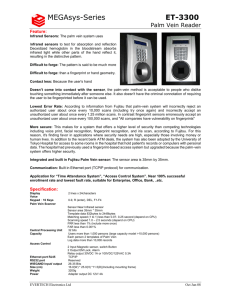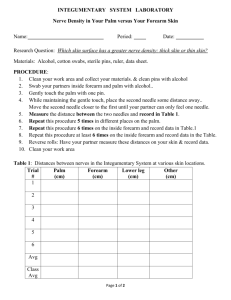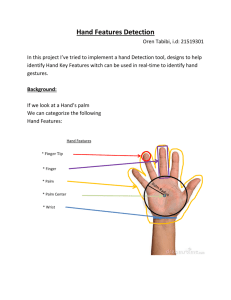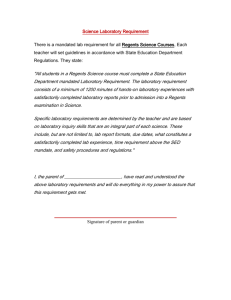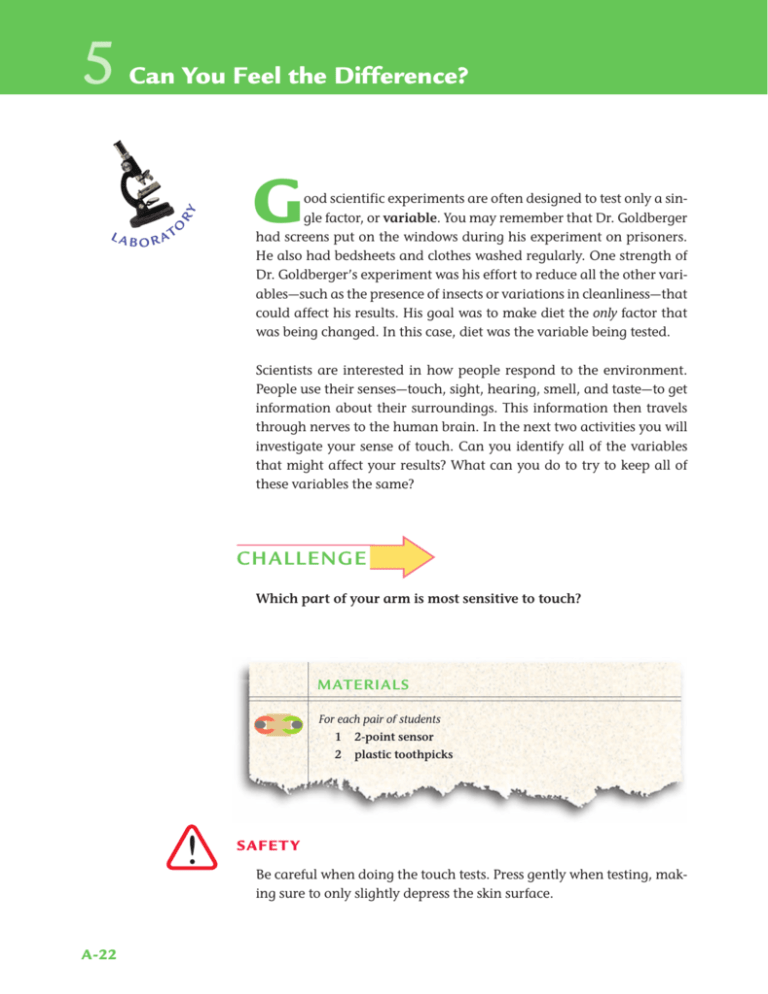
Can You Feel the Difference?
LA
O
RY
5
BO RA
T
G
ood scientific experiments are often designed to test only a single factor, or variable. You may remember that Dr. Goldberger
had screens put on the windows during his experiment on prisoners.
He also had bedsheets and clothes washed regularly. One strength of
Dr. Goldberger’s experiment was his effort to reduce all the other variables—such as the presence of insects or variations in cleanliness—that
could affect his results. His goal was to make diet the only factor that
was being changed. In this case, diet was the variable being tested.
Scientists are interested in how people respond to the environment.
People use their senses—touch, sight, hearing, smell, and taste—to get
information about their surroundings. This information then travels
through nerves to the human brain. In the next two activities you will
investigate your sense of touch. Can you identify all of the variables
that might affect your results? What can you do to try to keep all of
these variables the same?
CHALLENGE
Which part of your arm is most sensitive to touch?
MATERIALS
For each pair of students
1
2-point sensor
2
plastic toothpicks
SAFET Y
Be careful when doing the touch tests. Press gently when testing, making sure to only slightly depress the skin surface.
A-22
Can You Feel the Difference? • Activity 5
PROCEDURE
2.0 cm
1.5 cm
2- Point Sensor
LAB-AIDS
0.7 cm
1. Slide 2 plastic toothpicks into the 2-point
sensor on the side marked “1.5 cm.”
2. With your eyes open, investigate your
sense of touch by touching the skin of
your fingers, palm of your hand, and
forearm with the point of just one
toothpick.
3. With your eyes open, touch your
fingers, palm, and forearm with the
points of both toothpicks.
4. Record your observations in your
science notebook while your partner
investigates his or her own sense of
touch.
5. Have your partner close his or her eyes
while you touch the skin on his or her
fingers with either one or two toothpick
points. Touch just hard enough to see
that the points are barely pushing
down on the skin. Randomly alternate
between one and two points. Can your
partner tell the difference?
6. Create a larger version of the table
shown on the next page. In the
table, record your observations
about your partner’s ability to tell
the difference between one and two
points on his or her fingers.
â
A-23
Activity 5 • Can You Feel the Difference?
Table 1: Observations of Touch Sensitivity
Person Being Tested
Fingers
Palm
Forearm
(Name)
(Name)
7. Repeat Steps 5 and 6
on your partner’s
palm and forearm.
8. Switch places and
repeat Steps 5–7.
9. In your group of four, use
Analysis Questions 1 and 2
to discuss your results.
ANALYSIS
1. Which part of your arm—your fingers, palm, or forearm—was the
most sensitive to touch? What data do you have to support your
conclusion?
2. In your group, how many people found fingers to be the most sensitive part of their arm? How many found palms or forearms to be
the most sensitive? How similar were different individuals’
responses to touch?
3. Why was it important for the person being tested to close his or
her eyes?
4. Before scientists make comparisons, it is important that they perform well-designed experiments. In a well-designed experiment, all
of the variables, except the one being tested, are kept the same.
a. In your experiment, what variables did you keep the same?
b. Were there any variables (except for the one being tested) that
you could not keep the same?
A-24
Human Variation
LA
O
RY
7
BO RA
T
I
n the last two activities, you learned about your sensitivity to touch
on different parts of your arm. How can you find out if what you
learned about yourself applies to other people? You and your classmates will collect and compare data to find out how sensitive each of
you are to touch on the palm of your hand. Do you think everyone has
the same sensitivity to touch?
CHALLENGE
What is the smallest distance at which you can still feel two points?
How does this compare with other people in your class?
A-28
Human Variation • Activity 7
MATERIALS
For each pair of students
1
2-point sensor
6
plastic toothpicks
1
metric ruler (optional)
For each student
1
Student Sheet 7.1, “Touch Test Data”
1
Student Sheet 7.2, “Sensitivity to Two Points:
Class Results”
additional copies of Student Sheets 7.1 and 7.2
(optional)
SAFET Y
Be careful when doing the touch tests. Press gently when testing, making sure to only slightly depress the skin surface.
PROCEDURE
1. What is the smallest distance—0.7 cm, 1.5 cm, or 2.0 cm—at which you
think you can still feel two points on the palm of your hand? In your science notebook, record your hypothesis. Be sure to explain why you
made this prediction.
2. Identify your dominant hand. (This is usually the hand you write
with.) Throughout the experiment, you will test your dominant
hand.
3. Begin completing Student Sheet 7.1, “Touch Test Data.” Write in
your name and circle which of your hands is dominant. You will
begin by testing the palm of your hand, so circle “palm” as the part
of the arm being tested.
2.0 cm
1.5 cm
2- Point Sensor
LAB-AIDS
0.7 cm
4. Since you will test your partner (and vice versa), switch student
sheets so you can record his or her data on his or her sheet.
5. Slide 2 toothpicks into each side of the 2-point sensor as shown on
the left. You should end up with toothpicks on three sides, with the
toothpick points 0.7 cm apart, 1.5 cm apart, and 2.0 cm apart.
â
A-29
Activity 7 • Human Variation
6. Practice using the 2-point sensor so that you can safely and easily
test using any of the three sides.
7. As the experimenter, you will use the 2-point sensor to test your
partner. Record your partner’s responses on Table 1, “Touch
Response,” on Student Sheet 7.1. It is important that you move across
each row in Table 1 as you record your partner’s response.
For example, when you do Trial 1, you will work across the first row:
a. Turn the 2-point sensor to the 0.7 cm side and touch your partner’s palm with just one point.
b. Turn the sensor to the 1.5 cm side and touch your partner’s
palm with just one point.
c. Turn the sensor to 2.0 cm and touch your partner’s palm with
two points.
8. Before starting the touch tests, ask your partner to close his or
her eyes. The partner being tested should not try to “guess the right
answer.” The goal is to report what you really feel—one point or two.
9. Use Table 1, “Touch Response” to test your partner. You can start
with any row you want, but be sure you complete all the rows. Don’t tell
your partner which row you are using. Remember to touch just hard
enough to see that the points are barely pushing down on the skin.
After each touch test, have your partner report whether he or she
feels one or two points and record the response.
10. After you complete all the touch tests in Table 1, have your partner
test you by repeating Steps 7–9.
11. Give your partner back his or her original Student Sheet.
12. Complete the rest of Student Sheet 7.1.
13. If you have time, repeat this experiment to test the sensitivity of
your fingertips and your forearm.
A-30
Human Variation • Activity 7
ANALYSIS
1. a. According to your data, what can you conclude about your sensitivity to 2-point touches? How does this conclusion compare
with your hypothesis?
b. Compare your results with those of your partner. How similar or
different are your results?
c. Compare your results with those of another pair of students.
How similar or different are your results?
2. Look at the class results on Student Sheet 7.2, “Sensitivity to Two
Points: Class Results.” Compare the smallest distance at which you
could feel two points with the results of the rest of the class. What
can you conclude about the sensitivity of different people to
touch? Is it possible to make conclusions about people in general?
3. You were able to determine the smallest distance at which you
could still feel two points using only the 2-point touch data. The 1point touches acted as a control. Why would you need a control
when experimenting on people?
4. a. A good experiment is reproducible. What parts of this experiment are reproducible?
b. How could this experiment be improved?
5. What factors make studying people scientifically difficult? How do
scientists deal with these factors in a well-designed investigation?
6. Design an experiment to determine a person’s sensitivity to
sound. Assume you have a machine that you can set to produce
sounds of varying volume (measured in units called decibels).
Hint: Think about how you tested your sensitivity to 2-point
touches.
EXTENSION
Go to the SALI page of the SEPUP website to find out how to post your
class data on the site. Look at the data posted by other students. What
can you conclude about the sensitivity of different people to touch?
What effect does sample size have on your conclusions? Explain your
ideas.
A-31
Elements of Good Experimental Design
•
builds on previous research
•
describes all steps in procedure clearly and completely
•
describes all data to be collected
•
keeps all variables, except the one being tested, the same
•
includes a control (or placebo) for comparison
•
uses an appropriate group of subjects
•
may include a large sample size
•
may include multiple trials
•
can be reproduced by other investigators to give similar results
•
respects human and animal subjects
©2001 The Regents of the University of California
Elements may vary, depending on the problem being studied.
Science and Life Issues Transparency 7.1
A-81
Name
Date
Touch Test Data
Dominant hand:
right
left
Part of arm being tested:
palm
fingertip
1.
forearm
Work across each row in the table, using the 2-point sensor.
Table 1: Touch Response
Trial
©2001 The Regents of the University of California
2.
Points at 0.7 cm
Correct?
Points at 1.5 cm
Correct?
Points at 2.0 cm
Correct?
1
1
Yes
No
1
Yes
No
2
Yes
No
2
2
Yes
No
2
Yes
No
2
Yes
No
3
1
Yes
No
1
Yes
No
1
Yes
No
4
1
Yes
No
1
Yes
No
1
Yes
No
5
2
Yes
No
2
Yes
No
1
Yes
No
6
1
Yes
No
2
Yes
No
2
Yes
No
7
2
Yes
No
1
Yes
No
2
Yes
No
8
2
Yes
No
2
Yes
No
1
Yes
No
9
1
Yes
No
2
Yes
No
2
Yes
No
10
2
Yes
No
1
Yes
No
1
Yes
No
Use the data from Table 1 to complete Table 2. Be sure to circle “palm” in the title of
Table 2. Count the total number of “yes” responses for 1-point and 2-point touches for
each distance in Table 1. Write that number in the appropriate box. For example, write
the number of “yes” responses for 1-point touches at 0.7 cm in the upper left box.
Table 2: Determining Sensitivity of Your (Palm / Fingertip / Forearm)
Correct Number of:
0.7 cm
1.5 cm
2.0 cm
1-point touches
2-point touches
3.
What is the smallest distance—0.7 cm, 1.5 cm, or 2.0 cm—that you correctly felt 2 points
at least three times? This is the closest distance at which you could feel two points.
Science and Life Issues Student Sheet 7.1
A-83
Name
Date
Sensitivity to Two Points: Class Results
Use the class data to complete the bar graph below.
Graph 1: Sensitivity Bar Graph
30
25
Number of students
20
15
©2001 The Regents of the University of California
10
5
0.7
1.5
2.0
Distance (in cm) between points
Science and Life Issues Student Sheet 7.2
A-85
INQUIRY SCORING GUIDES
FOR MIDDLE SCHOOL
1. Designing Investigations
(DI)
2. Organizing Data
(OD)
3. Analyzing Data
(AD)
from SEPUP (Science Education for Public Understanding Program)
©2005 The Regents of the University of California. All rights reserved
T R A N S PA R E N C Y
Scoring Guide: Designing Investigations (DI)
What to Look For
Response states a design and specifies data to be collected for the investigation.
Procedures are described completely and accurately.
Level 4
Above and beyond
Student accomplishes Level 3 and goes beyond in some significant way such as:
• identifying alternate procedures.
• suggesting improved materials.
• relating clearly to scientific principles and approaches.
Level 3
Complete and correct
Student’s design is appropriate and has a reproducible procedure, if required.
Level 2
Almost there
Student’s design or procedure is incomplete AND/OR has significant errors.
Level 1
On your way
Student’s design or procedure is incorrect or demonstrates a lack of
understanding of the goals of the investigation.
Level 0
X
Student’s design or procedure is missing, illegible, or irrelevant.
Student had no opportunity to respond.
from SEPUP (Science Education for Public Understanding Program)
©2005 The Regents of the University of California. All rights reserved
T R A N S PA R E N C Y
Scoring Guide: Organizing Data (OD)
What to Look For
Response accurately records and logically displays data.
Level 4
Above and beyond
Student accomplishes Level 3 and goes beyond in some significant way such as:
• using innovation in the organization or display of data.
Level 3
Complete and correct
Student logically presents complete and accurate data.
Level 2
Student reports data logically
Almost there
Level 1
BUT records are incomplete.
On your way
Student reports data
BUT records are illogical
OR records contain major errors in the data.
Level 0
Student’s data is missing, illegible, or irrelevant.
X
Student had no opportunity to respond.
from SEPUP (Science Education for Public Understanding Program)
©2005 The Regents of the University of California. All rights reserved
T R A N S PA R E N C Y
Scoring Guide: Analyzing Data (AD)
What to Look For
Response accurately summarizes data, detects patterns and trends, and draws valid
conclusions based on the data used.
Level 4
Above and beyond
Level 3
Student accomplishes Level 3 AND goes beyond in a significant way, such as
• explaining unexpected results.
• judging the value of investigation.
• suggesting additional relevant investigation.
Complete and correct
Student analyzes and interprets data correctly and completely
AND Student’s conclusion is compatible with the analysis of the data.
Level 2
Student notes patterns or trends
Almost there
BUT does so incompletely.
Level 1
On your way
Student attempts an interpretation
BUT ideas are illogical
OR ideas show a lack of understanding.
Level 0
Student’s analysis or interpretation of data is missing, illegible, or irrelevant.
X
Student had no opportunity to respond.
from SEPUP (Science Education for Public Understanding Program)
©2005 The Regents of the University of California. All rights reserved
Activity:
Variable:
Date:
ID
Moderated
MODERATORS
Student
A
B
C
D
E
F
Score
SEPUP Assessment System ©The Regents of the University of California
Student Sample Answers
Design an experiment to determine a person’s sensitivity to sound. Assume you have a
machine that you can set to produce sounds of varying volume (measured in units called
decibels). Hint: Think about how you tested your sensitivity to two-point touches.
Student A
I would put a person in a sound booth and ask them to put on a pair of headphones. I’d ask them
to raise one hand when they heard one beep. If they heard two beeps, they would raise two
hands. Only the one beep test would go toward their sensitivity.
Student B
In order to stop other sounds from interfering with the experiment, I would have the person go
into a small room by themselves with a window through which they could see me. They would
wear headphones. I would ask them to raise their hand every time they heard a noise. Then I
would play a recording of beeps, ranging from loud to very soft, played in a random order. I
would test both ears and record the results by when and what side they raised their hands. I
would test ones they missed a second time, to be sure they really couldn’t hear it. Then I would
compare those results with average results from previous experiments by me. I would use a
recording so they wouldn’t see me flip a switch each time and would have to rely on their sense
of hearing.
Student C
1.
Sit in a chair with back to beep machine.
2.
Put on head phones.
3.
Your partner will put in what beep in what ear she wants the beep to be in. Then she will
record it on your worksheet.
4.
You and your partner will switch places.
Student D
First place the subject in a sound proof room, with a chair as its only furniture. The subject wears
a head set and is told to press a buzzer whenever they hear a noise. The subject can’t see when
the tester presses a button to make a noise. The tester makes the noises at different decibels,
sometimes loud, medium, or soft. For a control, sometimes there is no sound at all. The subject
presses a buzzer on the side where they hear the sound. Each sound level (high, medium, low) is
tested three times for each ear. If the person hears it at least two times, they are sensitive to that
loudness. You should also do it for different pitches, because some people can hear high or low
pitches (frequencies) better than others.
Student E
My experiment is where you have to wear headphones and someone will make a beeping noise
on just one ear. Then the volunteer would point to the ear that he/she heard the noise from. And
that is how you could determine someone’s sensitivity to sound.
Student F
If we had a decibel meter we could make a sound very softly. We could then increase the volume
until they heard it then measure the sound on the meter. As a control we could have them
identify the sound that they heard.
Copyright 2005 Regents of the University of California



